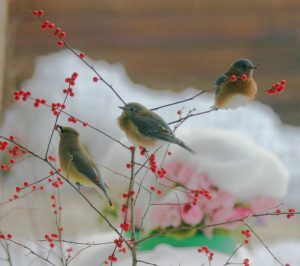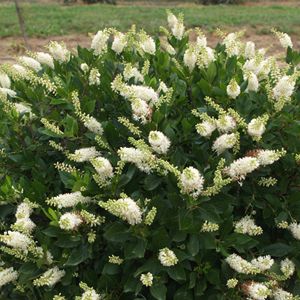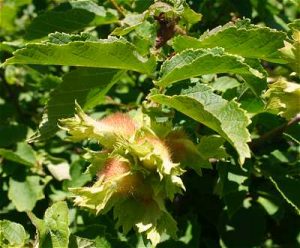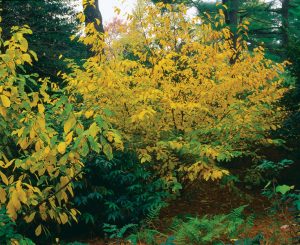
Life in the Briar Patch: Helping Our Avian Guests By Keeping It Natural
By Hatti Langsford
From Issue 14: Spring 2012
My approach to landscaping is most kindly described as haphazard. This’s why my property looks something like Brer Rabbit’s briar patch. I spend more money on plants than I have any logical justification for, and feel sorry for the innocent shrubs that pit their survival skills against the resident invasive bullies. Every year I tackle some section of my …let’s just call it a yard …although some (including my new husband) might choose a different term. By June, nature’s relentless creeping green reclaims most of my work. (I have the same “survival of the fittest” approach to laundry-which might help to explain my wardrobe.)

A Cedar Waxwing and a pair of Eastern Bluebirds on a Winterberry.
In an attempt to make our landscape more manageable, my husband suggests we brush-hog and plant something that can be mowed (you know, like grass?) I walk him through the property and point out all the beautiful natives that manage to survive: nannyberry—with fruits and flowers that native birds and insects rely on; gorgeous fronds of sensitive fern; black willow that is host to swallowtail butterflies and is the original source of aspirin…(which is what he needs after realizing that I want him to go through our two and a half acres and carefully remove only non-native species…) “I need to find a native replacement for the Rose of Sharon before we take them out,” I ramble on, “because the hummingbirds might miss them; and I will miss the hummingbirds … I wish I could get those cardinal flowers established…” I finally notice his glazed expression and realize I have overwhelmed him …again. (We bought him a nice chainsaw to a reward his patience.) I am not seeking the hard way, but all the best things seem to require a thoughtful approach.
As a naturalist I bear witness to a largeness of life. I see the richness in a tangle of plants, and also see our landscape from a bird’s eye view. A bird is denied the written language which sets our species apart and cannot read a sign denoting a park or preserve―but they read perfectly well, in the fabric of habitat, the gaping hole that is a lawn. The least I can do for these delightful avian guests after their exhausting 3,000-mile flight over ever-dwindling habitat is to continue to knit my yard back into the fabric of nature. To this end I’m setting out some new plants and have chosen four species that will hold up in the wash. Shrubs are tricky. In nature they are transition plants that edge forests, although they bide their time in the understory awaiting an opening. These are four favorites:
Sweet Pepperbush (Clethra alnifolia) 
The sources of the enchanting scent around Lake Awosting in summer; butterflies love it. It is usually coastal and unusual at the elevation where it is found in the gunks. It doesn’t mind wet feet and does well in Gardiner’s heavy clay soil. Supposedly it grows to about seven feet, though I have never seen it taller than four feet.
Winterberry (Ilex verticillata – photo with Waxwings, above)
This is a holly with mildly poisonous berries, but is a beautiful plant that birds depend on in winter. In good conditions it can grow to 15 feet but I’ve never seen it that tall. A good choice under a shade tree it likes (yes) wet soils. It is listed as at risk of becoming rare due to collecting. A related species in the genus has the unappealing species name of vomitoria and is credited as being the only North American native that contains caffeine.
 Hazelnuts (Corylus ameriana)
Hazelnuts (Corylus ameriana)
Hardy. Plant males and females and they will yield a surprising number of delicious tiny hazelnuts. They grow to 10 feet, but mine are several years old and holding at around four feet tall.
Spicebush (Lindera benzoin)
A delightful citrus scent when leaves are crushed; the leaves, twigs and fruit can be dried for tea or used as a native alternative for allspice. This very pretty shrub attracts bees, birds and butterflies and turns golden yellow in fall. Plant male and female plants. Up to seven feet but I rarely see them higher than three feet tall.
Some additonal notes that might help … Keep in mind that the worst way to measure soil pH is to buy plants, plant them and wait to see if they survive. Also, it is not enough to buy the pH kit―you have to actually read the instructions and use it. If your yard is “naturalized” like mine (euphemism for allowed to grow feral) and you are a pretty good naturalist; you can assume your pH. If you live off the ridge and you want to plant blueberries you should probably try to acidify your soil with supplements. The plants I have suggested have wide pH tolerances.
As far as where to buy, it is worth a visit to Francis Groeters at the Catskill Native Nursery on Samsonville Road in Kerhonkson.
And, a final thought: I LOVE the phrase mildly poisonous. Only a handful of plants on our planet are deadly poisonous; most poisonous plants only make people a little sick. Many of these have healing properties if prepared properly and many of them are the foundations of contemporary medicines.
